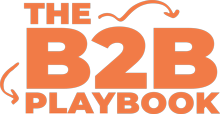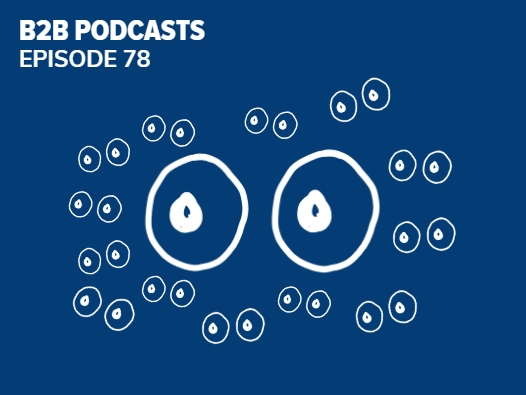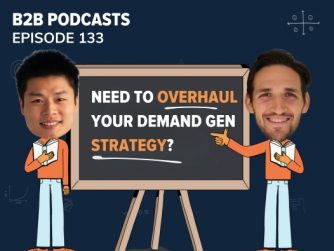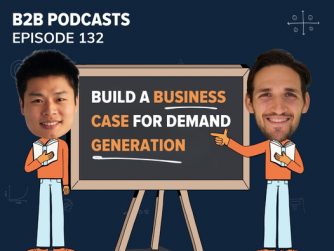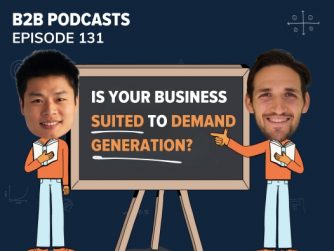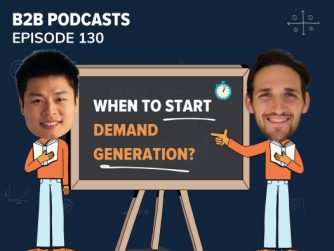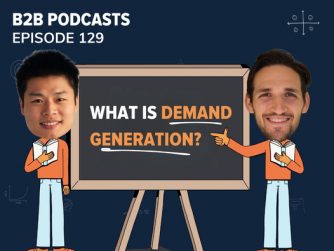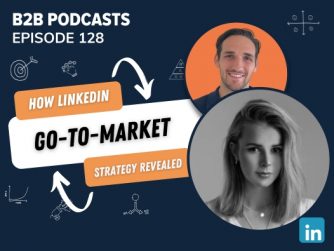Still struggling to keep up with content creation?
Even with a system in place, new channels and their content requirements can quickly blow out your workload.
We’re here to help, particularly you small business marketers!
We recap our content repurposing framework and process, but also give you some great tips on how to take it to the next level!
Watch The Episode
Sign up to our newsletter for the latest news and summary of the best content.
If you enjoy the podcast. Would you kindly consider leaving a short review? It takes only a minute and helps make a big difference in getting those amazing guests! We also love getting your insights by reading the reviews!
Transcript
[00:00:00]George: welcome back to the B2B Playbook listeners. Today we are [00:01:00] talking about how you can get 20 times more eyeballs on your content without creating more content or using ads to boost it. Kev, it’s all about content repurposing, which we’ve spoken about before, but we’re doing an advanced version this time and we’re doing it in season four of the B2B playbook.
Kev, what is season four? All.
Kev: Well, George season four, as you know and our listeners hopefully know is be better, so be better is the fourth B in our five Bs framework and the first three Bs, we prepped you to deeply understand your customers, to start creating content that is truly helpful to them and start to build a relationship of trust with them.
Through that content and BC the third. B, we showed you how to amplify your helpful content to the right people and therefore accelerate your growth. And in this season, be better. We’re talking about optimizing your B2B marketing workflow. Now that you have all those fundamentals in place, how can small marketing teams with limited [00:02:00] resources that need to punch above their weight do so and to really get the attention of their dream customer?
George: That’s it Kevin. The reason we’re addressing this again and be better is look, we’ve found that the most efficient and powerful way to create content that really resonates and is constantly and consistently on message is content repurposing. What’s content repurposing, kev? It’s taking a pillar piece of content, like a video podcast, like the B2B playbook, for example, and then chopping it up into little segments and different formats, so it can become socials for YouTube.
You can put it on TikTok, it can become the foundation of your LinkedIn post. It can become a blog. The blog can become a newsletter, and so on and so forth. And as we said, ke if we cover this and be helpful, but hopefully you’ve settled into a good rhythm of content Rep Purpos. And this episode, we’re gonna cover it again, but we want to talk about how to take it to the next.
level
Kev: But before we jump into that let’s talk about why it’s important. So marketers and small teams are so strapped for time and [00:03:00] resources. We know that you have limited access to subject matter experts to help create content as well. At the same time, you need your dream customers to see your content if they’re going to trust you, and to start forming that relationship of trust with your brand and eventually buy from you.
So that’s where advanced content market. So that’s where advanced content repurposing comes in. It can take that expert podcast blog that you’ve written already or that you’ve had the chance to do before which maybe only got 50 downloads or 50 views, and then get 20 times the eyeballs on that same piece of content with not a huge amount of extra lift. the good news listeners, is that much of the repurposing process can be outsourced, or you can even use the AI tools that we’ve talked about in previous episodes to help you do it faster.
George: All right, Kev. Look, it’s clearly very important and listeners, we’re gonna take you through three really key things today. The first we’re gonna remind you about. What content repurposing is, we’re gonna show you how we [00:04:00] do it in our business as an example. Second, we’re gonna give you tips on how to level up your content repurposing so you can get the most impact on each channel.
So this is more of an advanced way of doing it. And finally, we’re gonna show you how you can scale this process and outsource it with virtual assistance or insource it with. All right, let’s kick off Kevin, with what is content repurposing? Kev, what is it? Tell me.
Kev: Well, it’s about starting with that pillar piece of content, as we mentioned before. That’s done by subject matter experts or in conjunction with them and it should be one that you create on a regular cadence and then chopping it up and using various different parts of it to create all the content that you need.
So one example for us, we film our video podcast once a week, and from that we get. . And listeners, if you are watching, or viewers rather if you are watching this on YouTube, you can see on the whiteboard there, we have that pillar piece of podcast, webinar event, whatever it might be for us, it’s the [00:05:00] video podcast right at the top there and we start splitting it up.
We get a 40 minute. Also podcast from it. We get a 40 minute or so YouTube video from it, which is just a video version of that podcast with some tweaks for the video format like this whiteboard is, and then we also get 12 YouTube shorts where we cut up different really important points within that podcast.
And we put them in a short for easy consumption as well. obviously. Then we can turn those and repurpose those again into tos for those of our audience who are using that platform instead. And we also get 12 LinkedIn posts from that. Each of those points that we’ve really chopped up, we can do another post about that same topic on LinkedIn, because as you know, listeners, not everyone is on the same platform in your audience.
So maybe some of our very lovely listeners is in fact mostly on LinkedIn and not listeners at all. So we make sure we service that segment of our audience as well. And we’ll often turn some of those key ideas [00:06:00] into articles as well.
So we might get around three pieces of written content from a particular pillar piece of content, the podcast in this case as well. And we also do a newsletter as some of you might know, we do a newsletter. And again, we repurpose some of those ideas and really call them out in the newsletter for those who just follow us through the email subscription.
and we can do all this and we’re able to do it without it being our full-time job. And that’s the key part of all this, isn’t it, George? Is really content purposing there is to help. The purpose there is to help us get on top of the content creation process.
George: and that’s without outsourcing it. Kev. So look, this whole content creation repurposing process for you and I takes us like around eight hours a week. It used to be four and a half. We haven’t got worse, we promise. We’ve just added in YouTube and newsletters into the mix. So it takes us a little bit longer.
But once we start to outsource that process, I’m sure we can [00:07:00] bring so much of that right back down, Kevin. Kevin and I are also lunatics. We have chosen to create our pillar piece of content every single week. Now, do we need to even have like our pillar content every week, Kev? It’s probably overkill, probably not, but we are doing it because we’ve dedicated to sharing our five B’s framework over 100 episodes.
But for you listeners, probably like once a month is probably enough for your pillar. Of content. So even if you’re not outsourcing anything, can you spare eight hours a month for your whole content engine to drive and thrive? I think you probably can. I think you can.
And Kev. The benefits are massive, right? Because content repurposing it makes you look so much bigger than you really are. We’re just two blokes sitting behind our laptops and the amount of content that we can pump out is huge. It’s up there with some really large organizations.
It [00:08:00] also creates a highly efficient content creation system that actually gets seen by a lot of people. So because we’re not just focusing on creating content all the time, but we’re focusing on repurposing and distributing it, that means that we care about whether or not that content was seen, just not whether or not it was created.
And that’s a key part that so many marketers, miss Kevin, is they just try and stick to their schedule of, create a blog post a month, do this once a month, do that once a month. But they don’t spend that time actually distributing and repurposing that content to be distributed, so it gets seen by our dream customers. And finally, Kevin, content repurposing makes sure that your message is repeated in different formats, in different places. And repetition of the same message is absolutely essential in marketing.
Kev: Yeah, I think that’s one that we really struggle with when we started content repurposing. I would often question, and, you know, we’d have discussions about this [00:09:00] George, whether repeating the same content over and over again was actually helping our audience, but we started to realize that a lot of our audiences.
Come into contact with us only through one or two of these channels so we’re not actually repeating the message that many times to the vast majority of our audience. And even if we were, as you said, repetition of a message is essential in marketing. And so very important in this day and age when there’s a real lack of attention.
Social media just goes out of your head very quickly. Even with saving posts certain ideas are hot today and are gone tomorrow. And so when you’re repeating certain messages even a week later, it’s really bringing back to the fore something that’s very important and that should be.
George: that’s such a great point Kevin. People like to consume information in different ways in different places, and the reality is people need to hear the same idea or concept at least a few times for it to stick in their brain. Obviously, the more creatively [00:10:00] you tell, Or convey that information to someone probably the more receptive they’re gonna be to you.
But we do still need to have those multiple touchpoints to try and take up some of that valuable real estate in their brain with the information we’re trying to get in there.
All right, Kev, let’s look at how we actually do this. And listeners, if you wanna check out our YouTube channel. Again, we have a little diagram that I’ve painstakingly drawn. Kevin, I don’t know what you think of my art skills.
Perhaps they leave a little bit to be desired. But Kevin, I will have you know that I have several people reach out to me on LinkedIn and tell me that they like my drawings. So
Kev: Yeah. Maybe it’s because it reminds them of a simpler time in uh, in
their childhood . But
George: nostalgia, Kevin.
That’s a powerful marketing. Leave it. Appall. Nostalgia’s. Very
Kev: I certainly appreciate your efforts. I appreciate and applaud your efforts
George: Oh, very good. All right. How we do it. First of all, that first step, like we said, look, we record our video podcast. That’s [00:11:00] Kevin and I at the beginning. We’ve pre-written a whole lot of show notes and talking points that we want to cover, and we record it with video. So that’s our pillar piece of content.
And from there, the repurposing journey begins. We use a tool called, Which is a fantastic tool that allows us to create a effectively a 40 minute YouTube video because we like to release the long format of the podcast in video format two. And Descript makes it really easy for us to slice in multiple camera angles, to bring in graphics like my beautiful graphics I’ve drawn here. We then duplicate that video that we’ve done and we’re still in script, and we rip that audio into script to create the podcast. But of course, like the introduction and the outro that we’ve created for the podcast is gonna be really different to the YouTube video because when it’s visual, like you’ve gotta be able to keep people hooked.
When you guys are listening to us on the podcast, we know that you’re probably driving, you’re washing dishes. So we don’t need to be [00:12:00] as attention grabby. We don’t need to be changing scenes. We don’t need to fight as hard to keep your attention. We just have to focus on providing really good information and hopefully we don’t annoy you and switch us.
but YouTube is a little different. And so we’ve gotta do things like change that intro and that outro Kev. We’ve also created templates for each format in script, and I’m just showing that on the video again, what our templates look like. So then it’s really easy for us to duplicate that and turn the video podcast into our YouTube shorts, into tos, into our linked.
Like little video extracts as well.
Kev: that’s the listeners. We don’t want to be repeating, very manual work. So one of the things that We do in this process is try and make as many of these things as automated as possible and easy to reapply to a different week, a different.
George: Kev, the transcript is also very easily pulled from the script, so [00:13:00] it’s really good at turning our. Our voices into words on a piece of paper. It comes out like a Word doc, and the transcript that you get from it is really. And so we can then turn that into extended show notes. We can post that transcript on our website, which we do.
And we can also use the contents of whatever we said into LinkedIn posts. Sometimes Kevin says something that’s really smart and I’m like, oh, I wish I said that. But rather than claiming credit for it, I can just take his words reformat them into a LinkedIn post and pretend that I’m Kevin and I said some really smart things.
and then Kev, once we get those LinkedIn posts we look at which one’s performed really well, which one’s got the most engagement, and then we go, oh, that’s a really good topic to turn into an article because people clearly care about it. I don’t think I’ve even mentioned Kevin here, the fact that we turn this into a newsletter as well which is really a summary of the best of our content, but hopefully, This gives you guys a good indicator as to how Kevin and I are doing it [00:14:00] yourself.
And I think you nailed the key thing there, Kevin. It’s really about trying to turn it into a process for it to be as efficient as possible, because you’re gonna be doing the same thing again and again, and you wanna make it easier the second time you do it from when you did it the first.
Kev: Yeah. And you’ve got there in the diagram, George. you can outsource most of it. Indicated that at the moment we do it all ourselves because we love doing a lot of this stuff and it helps us learn as well. But it’ll certainly get to a point where we’ll look to, once we’ve nailed down the processes, it’ll certainly get to a point where we’ll also look to outsource different parts of this repurposing process.
And we’ll always be the ones making that video podcast right at the beginning. But obviously a lot of the work. From there to do the repurposing can be outsourced and probably should be outsourced at some point. So listeners, you can see this is very much a process that you can outsource very easily. [00:15:00] I think another thing to mention, George, is that we track all this in a Google sheet for each episode.
So it’s actually quite easy for people who aren’t. Text heavy or who aren’t very deep into the weeds with all the different platforms and tools you can use to actually keep on top of it and to make it a very successful content repurposing process. It’s very easy to do. We do this in a Google sheet, as I said, and We end up with that.
20 x number of IPOs on our content just from that repurposing alone. And if we obviously just created the podcast, we wouldn’t be getting anywhere near the amount of exposure we’re getting
now.
George: All right, Kevin, let’s look at. How we take this content repurposing to the next level. And look, we’re gonna start with the problem, which is, people are getting into this content repurposing thing. We’re seeing it more and more from companies, from creators, and really people were starting with things like video [00:16:00] podcasts.
And what they were doing is they were just taking video snippets from their long form content, posting them on social media. And look, initially that did get some attention. But as with marketing, as with getting people’s attention when so many other people are doing it, the competition is intense and you’ve gotta do something to make your content feel perhaps a bit more platform native.
Something to really get the attention of those dream customers who are on that platform. you know that boring long format video podcast that you did that you just took a little clip, you put some headline text over the top, and then you let it sit there for two and a half to three minutes. That doesn’t work anymore like that.
That just, people just scroll right past. We don’t care about that anymore because there’s too much of that out there. So how are we taking it to the next level, Kevin? What we said is we need to make our content feel more platform native. So for example, social content, like on YouTube [00:17:00] shorts, if you’re posting a video on LinkedIn, on TikTok, it needs to have a great hook.
It needs to change scenes quickly. It needs to be short, it needs to be snappy because in the context of that platform, that’s what the other really great content is doing, and you are competing with that other great content. You’re not just competing with your competitors, right?
Like we’re not just competing with other B2B marketers. We’re competing with everyone who’s trying to get our dream customers attention, whether they’re trying to sell them dog food or collagen or whatever it is. We’re competing with all those people. So we need to up our production game. We realize, Kev, that, YouTube video that’s gonna have better visual.
We again, we need to change scenes even though it’s like a 40 minute video clip. It’s great if we have multi-cam, so we’ve introduced like a few different camera angles. And of course, as we touched on earlier, you’ve gotta have a separate intro and outro because [00:18:00] we’ve gotta have a good hook and it’s gotta be visual.
Our podcast didn’t have that.
Kev: That’s it. George. listeners, the easy way to Take your content repurposing to the next level is to start adapt. Your content specific to each channel that you use, and add little things in your process to make it more specific to each channel. So as George mentioned before, we start with the video podcast and then we create different things to make it more suitable for YouTube or socials.
Things like the little drawings that he does, things like pull-ups of screenshots because they’re great. , as visual aids when the medium is video and it’s on YouTube or TikTok. Otherwise it’s just like me and George’s heads talking all the time, which is not great, and it gets boring pretty quickly. and as mentioned before, he’s got a different, camera angle that he can cut in between as well. And we start to record different intros outros and asking people to obviously like and subscribe on YouTube. That makes sense there, but that won’t make sense on a podcast or TikTok. So [00:19:00] things really need to be adapted to channel specific things.
And again, you can, and, we’ll talk about this next, but you can get channel experts to do some of
this work for you as you scale as well.
George: Kevin, thank you for the kind words about my drawings. Actually, I don’t know if you said nice things about it, but you just mentioned it, so thank you for mentioning and acknowledging it. All right. Now we’re on to the third. Point that we wanted to make in this episode, Kev, which is how to scale this by outsourcing or insourcing.
So outsourcing is getting someone external to your business to help insourcing is finding things or tools or people internally to help. So Kev, because you’ve created the pillar content, You are not actually losing value if you get other people to help you repurpose it. Now, there’s a big difference, listeners and viewers, between Kevin and I recording an episode on this content repurposing process versus just hiring a freelancer to write an article about it.
Kevin and I actually [00:20:00] have the experience. People trust our voice, people trust our face. We have stories, we have pains to share around trying to do this process for ourselves and our. . So it’s really different when you put the effort into that pillar content. But once we’ve actually recorded that pillar content and we know what it’s gonna be, you can document step by step the repurposing process to actually get help where you need it. So it’s the outsourcing and the insourcing is where you can get help with your content cuz they can help with all that repurposing stuff.
If you start with the experts from that original pillar piece of content.
Kev: Yeah, that’s a very important point, George. There’s a lot of benefits to , you creating the pillar content, making sure that it’s subject matter experts talking in that pillar piece of content. Because as we know, there’s a lot of benefits, SEO or otherwise, or just building that trust with your brand and our faces in this case. with being the face of that pillar [00:21:00] piece of content, it really grounds that knowledge that everything else is based on all the rest of the content is , on true expertise and true, helpful content. But as you said, George, once you have recorded it, it’s a very simple process to then just document in written step by step instructions on how to do the repurposing part.
So the key here is to try and get it to a point where, Step by step instructions is so simple that a Adobe could follow it. and to help you repurpose certain parts of the original piece of content, you can outsource this to an agency. As we mentioned before, you can also do this with a virtual assistant.
The instructions are good enough and they can really help you with everything from video editing to the posting. You can even get a freelancer to. Turn your podcast into articles as well, but just make sure that it’s still based on expert content. All the different pieces that come out is based on expert content.
You might wanna build into that process, a review step where you go through everything before [00:22:00] it goes out to make sure it’s still aligned. But again, you can still outsource 80 to 90% of that process. and the goal really is to outsource as much as possible here. I think George we could get our content creation and repurposing time to. Down to maybe to.
three hours a week, including that hour of recording and just spend time on the parts that nobody else can do the rest of your time. That really drives the business forward. So for us, that’s George. Engaging with people on LinkedIn or the different platforms that we’re in. For me, maybe it’s about exploring different topics that we really want our listeners to hear about next.
Those are the sort of things. No one else in your business, , can really do or outside your business can do.
George: So even little things Kevin, like if we know that our content is gonna be repurposed to each of these channels, could actually spend a little bit of time figuring out. And understanding each of these channels a little bit better, like figuring out what hooks work better for TikTok versus [00:23:00] YouTube shorts.
What keeps great retention across long format videos on YouTube and really starting to get into the intricacies of each of these platforms. And then just building in a process. So we might look at our YouTube videos, Kev and go, oh, look at around 15 minutes in on average, like half of our audience stops watch.
Well Then all of a sudden we could go, oh, maybe we need to just introduce like a new segment or do something to hold people’s attention at that 15 minute mark. Okay, what’s that gonna be? And then we introduce that into our show. That become then becomes part of the show, and we’re addressing that problem.
We’re fixing it, and we move on. So absolutely, Kev, gotta focus on those business outcomes and listeners. I can’t encourage you enough to please document this process. I personally have an aversion to documenting, but Kevin has taught me how important it is and it really has to be documented for a dummy.
Kevin has documented like. [00:24:00] All the processes in our business, even like the financial side of things. And Kevin, I’m a bit ashamed to admit, but even when I have to look at paying wages and super, I still go back to your how to notes and I follow it step by step. And my God, I’m so glad that they are there.
And it’s something that I do monthly, Kevin, but I still go back and look at the notes. So listeners please write your notes for an idiot like me,
Kev: Oh, George. Um, maybe not giving yourself enough credit. , there, I think everyone needs some notes. That’s the point Of the notes. listeners. It’s to help you when you don’t remember everything, when you have a million other things to do and you did something a month ago or a week ago even.
That’s what the notes are there for. And, notes for. ourselves when we feel like a dom on the next day or the next time we do so. Well, listeners, the next point here is you can also insource some of this process too. , So using AI tools like chat g p T, you can do things like feed your [00:25:00] transcript into a tool like that and ask it to create a LinkedIn post , of, maybe three ideas from a particular. Piece of the transcript and maybe also generate three article ideas from that same transcript as well. Now, the problem here listeners we touched on in a previous episode is you can’t fully rely on the output yet. So there’s obviously shortcomings with the output from these tools, and you really need to have a process in place to fact check it, to make sure it’s still relevant and maybe to tweak some or most of it in order to get it to where you like it to be.
You definitely weren’t safe as much, but you definitely still save some amount of time. Just not the same as currently. If you outsource the whole
process to maybe a human on the other side doing it.
George: yeah, AI can definitely help supplement this process. But I guess the other way of insourcing, Kev, is you just, hopefully you get another person in your marketing team that you can shift some of this [00:26:00] onto even then. Look, we would really encourage you trying to document this process, whether you’re insourcing and outsourcing.
It’s probably cheaper for the business if you actually outsource a lot of this process and free up. The other marketer in your team to work on things that drive the business forward. Alright, Kev, key takeaways for today. What were.
Kev: Now the first one, listeners, is content repurposing is a secret weapon for small marketing teams when done right, it’s extremely effective in. Sure that your expert content is being seen by as many dream customers as possible. Second, you can level up your content repurposing by preparing elements in advance to be used for specific channels, like a different intro or outro or more interesting visual elements.
And finally, the goal here is to outsource as much of it as possible , so make sure that you turn it into a repeatable process that you can document and hand off to somebody else.
George: very good. Kevin. Listeners and viewers, you can find links to [00:27:00] everything that we discussed in the show. Dots and Kevin and I are just so grateful that each week, more and more marketers are tuning in every Monday to the B2B playbook. Both the podcast and the YouTube, and if we could ask one thing, it would be to please leave us a short review on whatever platform it is that you are consuming this on, or do us one better and pass it on to someone who you think would get value from the show.
It’s a huge help to us and we’d really appreciate it. Thank you, Kevin. Thank you, listeners. Take care and see you next week.
Kev: Thanks, George. Thanks, listeners. See you.
[00:28:00]
